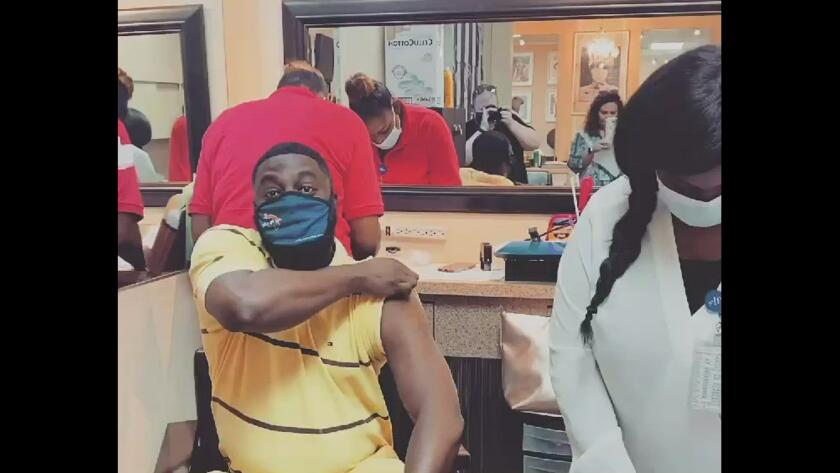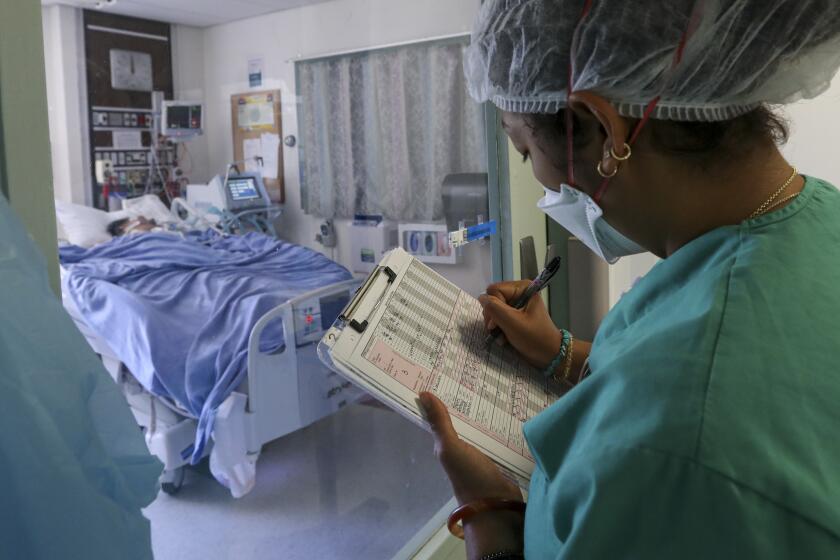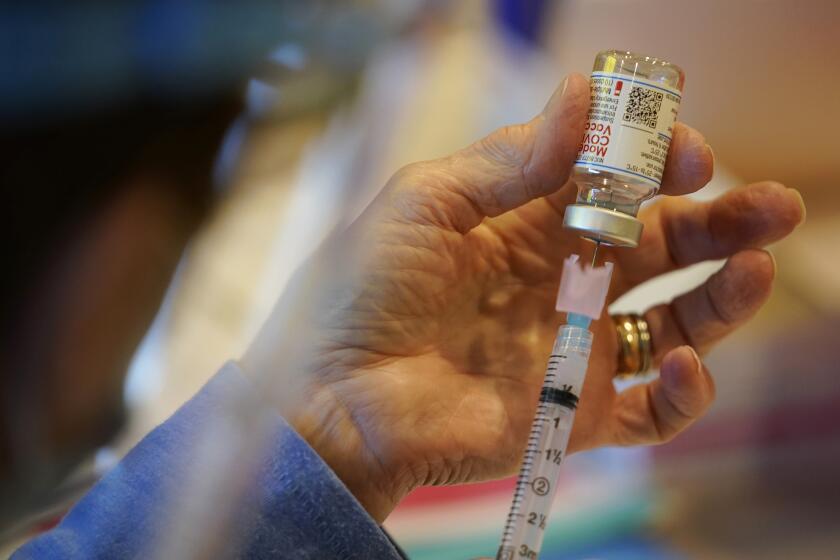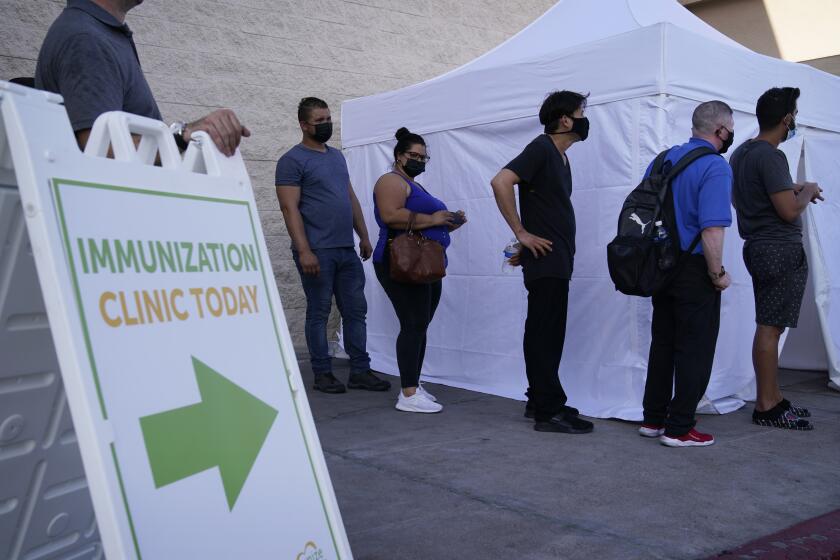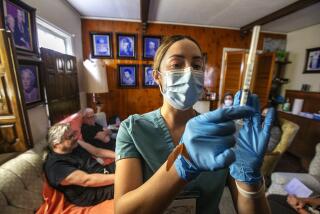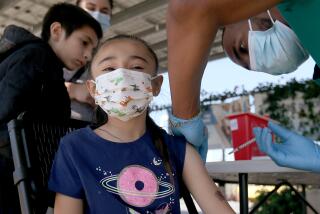Vaccine ‘obstinance’ is fueling Delta variant’s spread across America
- Share via
Robert Taylor, who owns three Fade ’Em All barber shops in Las Vegas, receives his first dose of COVID-19 vaccine at a mini-clinic in one of his shops.
- Share via
The Delta variant crept into Americans’ consciousness through a distant haze of funeral pyres. But now that the coronavirus strain first detected in India has burst upon communities across the United States, it has taken on a distinctly American look and feel.
In Giddings, Texas, it’s 147 infections that roared through attendees of a church ministry camp.
In Clark County, Nev., it’s a wave of close to 7,000 cases that sidelined three barbers at a Fade ’Em All shop in Las Vegas over the July 4 weekend even as a sister shop hosted a COVID-19 vaccine clinic.
In Grand Junction, Colo., it’s the invisible force behind outbreaks at a country music festival, church services, and a carnival in a mall parking lot. The Delta variant claimed the life of a 15-year-old girl in May and has maxed out capacity at the county’s two hospitals.
Experts at the Centers for Disease Control and Prevention estimate that Delta represents 58% of all new cases in the United States. In some places, particularly in the Midwest and upper mountain states, it has almost completely overtaken other coronavirus strains in just two months.
That’s quite a feat for a virus that arrived here around mid-March. Armed with some key mutations in the spike protein it uses to latch on to cells, the Delta variant was found to be 50% more transmissible than the Alpha variant first detected in the United Kingdom — a strain that already passed from person to person 56% more readily than the original virus that sparked the pandemic.
Early research suggested it might drive up hospitalizations, though the CDC has not found evidence to back this up. Still, Dr. Mike Ryan, who leads the World Health Organization’s Health Emergencies Program, called it “faster” and “fitter” than any strain that has come before it, and it’s now fueling outbreaks and deaths in at least 111 countries.
If the Delta variant catches you, will your COVID-19 symptoms be different than for people infected with earlier strains of the coronavirus?
The Delta variant has surged with terrifying speed and strength in Greene County, Mo., since it was first detected there in May.
Before Delta, COVID-19 hospitalizations hovered at 34. On June 21, 155 patients were in the county’s hospitals — a number not seen since the nationwide surge of COVID-19 cases in January. By July 8, the census rose to 192, with 70 in the critical care unit.
Greene County reported 19 COVID-19 deaths in June, virtually all caused by the Delta variant. Deaths are expected to double or triple in July.
“We are just being inundated with COVID cases,” said Kendra Findley, the county’s administrator of community health and epidemiology. All of them are caused by the Delta variant, she added.
We are just being inundated with COVID cases.
— Kendra Findley, administrator of community health and epidemiology for Greene County, Missouri
The places being overrun by Delta share something uniquely American: Despite overflowing supply of vaccines and strong evidence that they protect against the new variant, large numbers of residents have declined to inoculate themselves or their adolescent children.
Indeed, 93% of the U.S. counties with the highest rates of new infections have vaccination rates below 40%, according to CDC Director Dr. Rochelle Walensky. Many of these counties are strongholds of the Delta variant, she added.
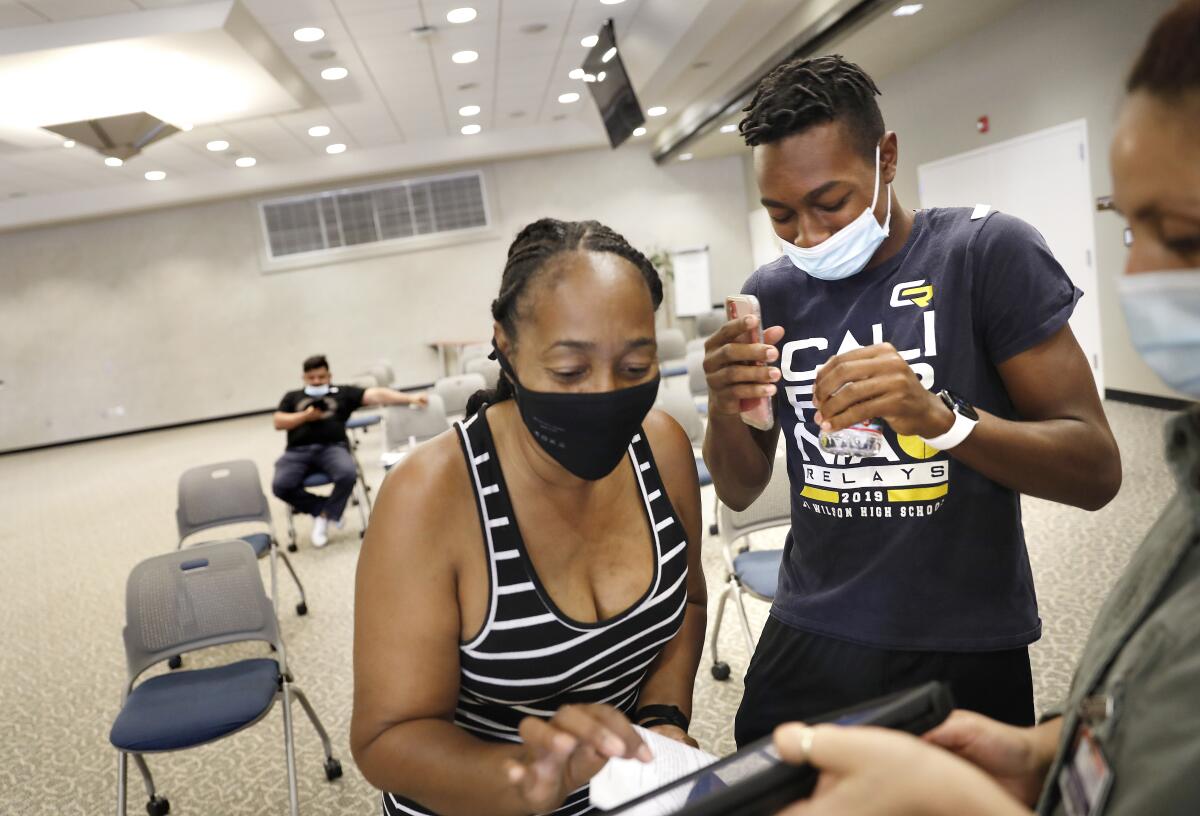
Low vaccination rates, a high rate of community transmission and the reopening of public spaces with scant protective measures “will certainly and sadly lead to more unnecessary suffering, hospitalizations and potentially death,” Walensky warned.
Some counties are woefully behind the national mark of 48.3% fully vaccinated, and some are just a little behind. But all have stalled in their efforts to vaccinate many more residents — and in some cases, to induce those who got a first dose to come back for a second one.
In Greene County, for instance, only 45% are at least partially vaccinated and just 40% are fully vaccinated. In Colorado’s Mesa County, home to Grand Junction, 46% are partially vaccinated and 42% have full protection. In Las Vegas and the rest of Clark County, 51% are partially vaccinated and 41% are fully vaccinated.
Lab tests and real-world experience offer reassuring evidence that COVID-19 vaccines offer a high level of protection against the Delta variant.
And in Texas’ Galveston County, home to Giddings, around 45% of residents are fully vaccinated, a number that has scarcely budged in recent months, according to the chief health officer there.
“I’d say there’s hesitancy and I’d use another word — obstinance,” said Dr. Philip Keiser, a University of Texas infectious disease expert who’s been Galveston County’s Local Health Authority since 2016. “There’s this attitude, ‘You can’t make me!’”
Facts don’t always help, Keiser added. Skeptical Galveston County residents objected when his county’s data dashboard began reporting the vaccination status of those who were hospitalized or died of COVID-19. (With rare exceptions, virtually all are unvaccinated.)
“‘You’re just trying to scare us!’ they said. I said, ‘Nope, just reporting the facts,’” Keiser said.
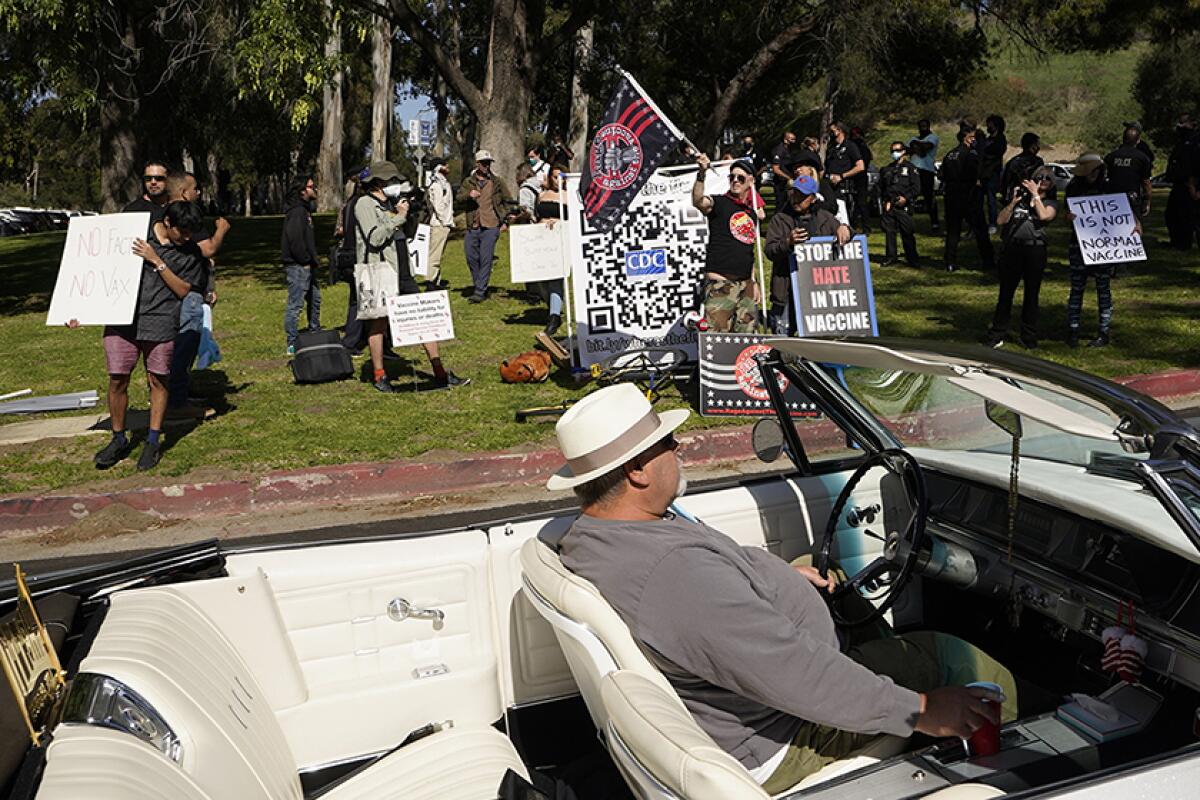
It’s a sentiment echoed by public health professionals in many of the corners of America — rural and urban, ethnically diverse and overwhelmingly white — where demand for COVID-19 vaccine has plummeted after a months-long run by the willing and eager.
By the end of May, Greene County had administered at least one shot of vaccine to roughly 35% of its population — just enough to roll back mask mandates and social distancing rules, Findley said. But the vaccination rate simply plateaued at that point as doubts about the vaccine began to harden.
“There’s also this sense of, ‘It’s a personal choice, you can’t tell me what to do.’ That’s a mantra that you hear all the time,” Findley said. “It’s hard to convince people the vaccine is a choice you make not just for yourself and your family, but for your community.”
Even in cities with high overall vaccination rates like Los Angeles (with 52% of the population fully vaccinated) and New York (with 64%), pockets of vaccine hesitancy have opened a door to Delta-fueled outbreaks. That risk will multiply when schools resume in-person instruction in the coming weeks, said Wan Yang, a Columbia University epidemiologist who studied Delta’s impact for the New York City health department.
The Delta variant and vaccine hesitancy in red states stall progress in President Biden’s battle against COVID-19 and threaten the economy’s revival.
Some of the communities where the Delta variant is seeding large outbreaks had largely been spared during earlier surges. That made it easier for residents to dismiss the pandemic as a distant threat. It’s also resulted in populations with very little natural immunity, leaving them particularly vulnerable to Delta’s onslaught.
Except for a few scattered outbreaks, the coronavirus had mostly bypassed Mesa County until the fall of 2020, when it experienced its first wave of cases, said Jeff Kuhr, executive director of the public health office there. As COVID-19 vaccines rolled in and people turned out to get them, Kuhr and his colleagues felt optimistic that they could get enough residents vaccinated to declare victory before too much damage was done.
But people have been wary of the vaccine — and the threat posed by the Delta variant hasn’t changed their minds.
“It is a trickle at this point,“ Kuhr said. “There’s just no sense of urgency.”
With local hospitals full and no sign of Delta letting up, he fears Mesa County’s luck has run out.
“We’ve always been ahead of it. But unfortunately, here we are,” he said.
In Las Vegas, past waves of COVID-19 weren’t enough for Darrius Bouyer to overcome his suspicions about the safety of the vaccines and the intentions of their makers. Then the 33-year-old barber tested positive for the coronavirus in June.
He’s just emerging from a funk of exhaustion, muscle aches and dizziness — and he’s starting to see the vaccines in a new light.
“After being affected like this, I’m definitely into doing more research,” he said. “I would never wish that on nobody. And I wouldn’t want to give that to anybody.”
Two of Bouyer’s fellow barbers tested positive for coronavirus infections around the same time. None of them had been vaccinated.
“Those barbers never caught it in the whole year since we reopened,” said Robert “Twixx” Taylor, owner of three Fade ’Em All locations. “And then, with the Delta arriving, the masks came off. That’s no coincidence.”
While the three were convalescing, Taylor got his first dose at a mini-vaccine clinic he hosted in one of his salons. He was one of 12 people to roll up a sleeve.
“Being a Black community leader — I had to get it,” Taylor said. He’s also determined to protect his 71-year-old mother, who is also vaccinated.
In Galveston County, a lot of vaccine converts would have to step forward — and fast — to keep the Delta variant at bay. Keiser is still hopeful, but he’s not so sure he can persuade enough people in time.
“This virus has had a way of humbling us,” he said. “Right now I’m just sitting on the edge of my seat seeing what happens next.”
